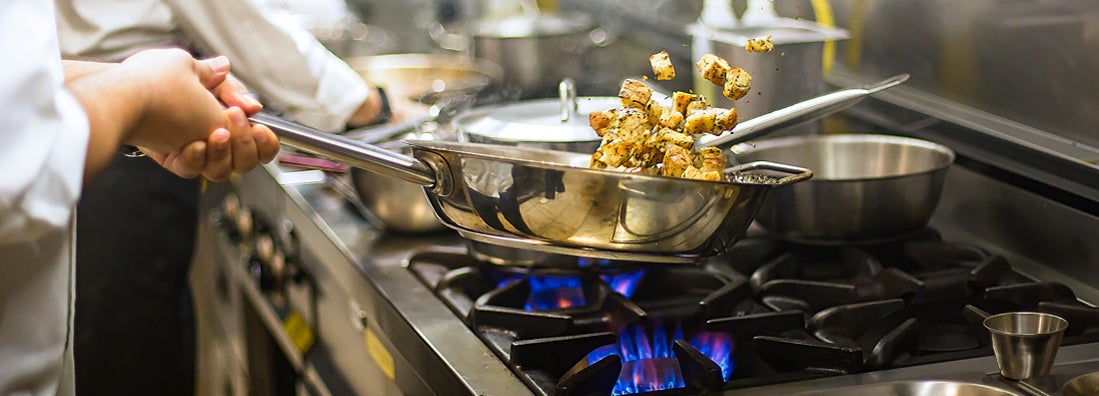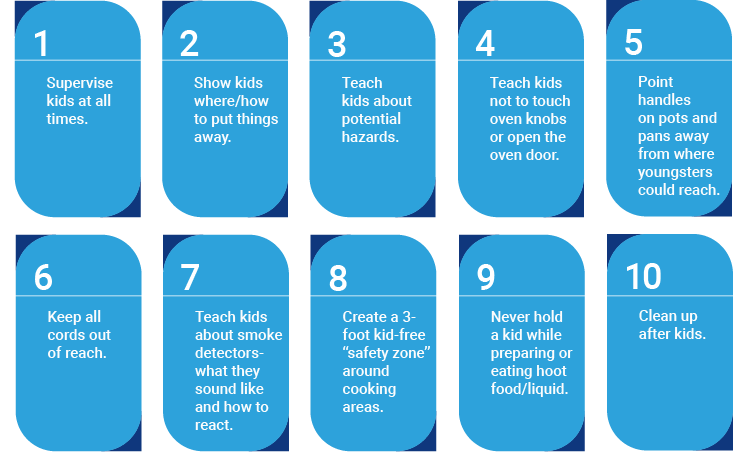Expert Tips for Hazard-Free Kitchen Safety

The kitchen can be the source of both pleasure and pain. It's the place where you cook up secret recipes or microwaveable Minute Rice, but it also houses many potential hazards – including sharp, pointy objects, extreme heat sources and slippery floors.
Now, unless you like your bacon (and everything else) burnt to a crisp, you'll want to take precautionary measures to keep yourself alive and in one (uncharred) piece.
Lucky for you, we've spoken to some experts who have sautéed, filleted, and spiced up a tasty serving of kitchen safety tips (with extra butter) just for you!
Tips for Food and Equipment Practices from the Restaurant Industry (Served with a Garnish)
Lindsay Wolfinger is a shift lead/manager at Ken's Bayside in Sellbyville, Delaware, and has 15 years of restaurant management experience. She said that safety begins with the proper training.
"I believe it's important for employees to know about potential disease and the reasons why we follow OSHA guidelines. When employees feel like they are knowledgeable and apprised, you get a much better work ethic and response from them," Lindsay says.
Lindsay also outlines some of OSHA's safety guidelines for us:
- Food storage: All food items must be properly stored and kept at the specified temperatures. Perishables are marked with date stickers, and employees must rotate items following the first-in, first-out method.
- Kitchen equipment: All food-prep equipment must be properly cleaned, sanitized and stored with safeguards, if applicable.
- Posters: Step-by-step hand-washing demos and sanitizing procedures must be displayed at all times.
- Daily checks: The temperatures of cold foods are checked against a master list, and equipment is tested for optimal function.
Here are a few other restaurant kitchen hazards, as outlined on OSHA's official website:
- Falls, trips and slips: Something as simple as a dropped onion slice can turn the kitchen floor into a danger zone. Many restaurants require that staff wear non-slip shoes, and OSHA requires employees to wear closed-toe shoes. Sharp items can be dropped on feet.
- Chemicals: Exposure to cleaning chemicals can cause adverse reactions. Cleaning protocols, such as wearing gloves, are important.
- Assault: The kitchen is a fast-paced, close-quarters working environment. Enforce personal boundaries and report any instances of harassment to management immediately.
- Lifting and bending: Employees must be trained on proper lifting techniques to prevent back and other injuries.
"Failure to clean up spills properly can lead to potential hazards and disease. Not cleaning them up or leaving items on the floor could lead to an employee or customer injuring themselves," says Lindsay.
Tips for Kitchen Safety from Fire Experts (Seared to Perfection)
All right, so now you feel confident of your ability to avoid accidental death, discomfort and disease in restaurants, but what about when you're lounging around your home kitchen in your Batman slippers and don't feel like catching on fire?
NFPA.org states: "From 2010-2014, U.S. fire departments responded to an average of 166,100 home structure fires per year that involved cooking equipment. These fires caused an average of 480 civilian fire deaths, 5,540 civilian fire injuries, and $1.1 billion in direct property damage."
Vito Maggiolo, public information officer for the Washington DC Fire and EMS Department, graciously gave us some home kitchen fire safety tips:
- Watch what you're doing: Never leave cooking unattended. Be aware of all items on stove tops. Move flammable items (e.g., oven mitts, wooden utensils, packaging, towels, curtains, pets, trashy gossip magazines, etc.) away.
- Dress for success: Avoid loose-fitting clothing that can come in contact with burners. Tie back loose, long hair.
- Clean it up: Clean cooking surfaces after use to prevent grease buildups that can ignite.
- Single-task: Beware of distractions while cooking.
So put the phone on the charger for a few minutes and opt to catch up on your next tasty round of nutrition, rather than your friend's recent vacation or the hottest new celeb couple.
"Unattended equipment is a factor in one-third of reported home cooking fires. Abandoned or discarded material, which may be related to unattended equipment, is a factor in 11% of the fires," says Lisa Braxton, a Public Education Specialist for the National Fire Protection Association.

Reference: from our friends at NFPA.org
Lisa adds that you shouldn’t operate a stove if you've recently consumed alcohol or a medication that causes drowsiness. She warns that you should turn off the stove if you leave the area, and that timers are an asset. (Just in case you get distracted by all those shiny, shimmery objects in your kitchen.)
Vito adds that it's imperative to keep a working fire extinguisher somewhere it can be easily accessed if meal-prep time suddenly becomes "Oh, &%*@!" time. Home sprinkler systems can also be a home-and-life-saving investment.
Also, it really is important to put up with the loud, obnoxious shrill of the “battery low” signal on your smoke detectors, and to check the batteries, preferably monthly. Carrying a ladder around and plugging your ears for a few seconds at a time is much less painful than fire damage. Put a smoke detector in the kitchen.
Lisa adds that it's important to regularly inspect the cords on all your equipment for cracks and other damage, to never plug equipment into an extension cord, and to keep to only one appliance per outlet.
What To Do If Your Culinary Art Goes Up in Flames
Let's say you've really messed up already (calm down, we're not saying "you" meaning you, we know you're intelligent and way too prepared for that now...). What the heck are you supposed to do to put out the flames after you've stopped screaming?!
"NEVER throw water on burning oil or grease. It will cause it to flare into a fireball," says Vito.
That's a good start. No fireballs, check. What's next? Vito breaks down the step-by-step process for us:
- Turn the heat off.
- Slide a lid over the burning pan or pot, but don't endanger yourself in doing so. Keep it in place.
- DON'T try to move the burning item, you'll likely burn yourself and drop it, causing the fire to spread.
- Call 911 and get out while alerting others in the home. Close all doors behind you to contain the spread of fire and smoke.
Tips from the Children's Menu: Kitchen Safety for Kids
So, adults, you're ready to rock and roll in the kitchen. But what about those sugar-hyped, sticky, unpredictable kids running through the house at Mach 10?
With the help of our experts, we've compiled a special list of kitchen safety tips, kid-style:
Rules for Kids in the Kitchen:
1. Supervise kids at all times.
2. Show kids where/how to put things away.
3. Teach kids about potential hazards.
4. Teach kids not to touch oven knobs or open the oven door.
5. Point handles on pots and pans away from where youngsters could reach.
6. Keep all cords out of reach.
7. Teach kids about smoke detectors - what they sound like and how to react.
8. Create a 3-foot kid-free “safety zone” around cooking areas.
9. Never hold a kid while preparing or eating hot food/liquid.
10. Clean up after kids.

Additionally, as a restaurant manager, Lindsay personally requires all younger employees to pass a special version of safety procedures and guidelines before they are allowed to work in the kitchen.
Now You're Cooking With(out) Fire!
Not burning the house down or causing severe bodily harm to yourself and others can seem like a daunting, all-consuming process. If you're ever feeling overwhelmed by the number of inanimate objects waiting to cause destruction to or kill everyone around you, we hope you can return to this list to calm your nerves.
Good luck - and may all your future kitchen creations be saliva-inducing morsels, with a side of safety.
Huge thanks to our expert sources for their insights and answers: Vito Maggiolo, public information officer for the Washington DC Fire and EMS Department; Lisa Braxton, public education specialist for the National Fire Protection Association; and Lindsay Wolfinger, shift lead/manager for Ken's Bayside restaurant.
